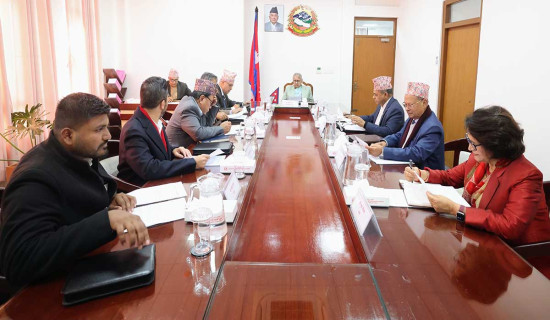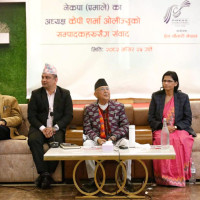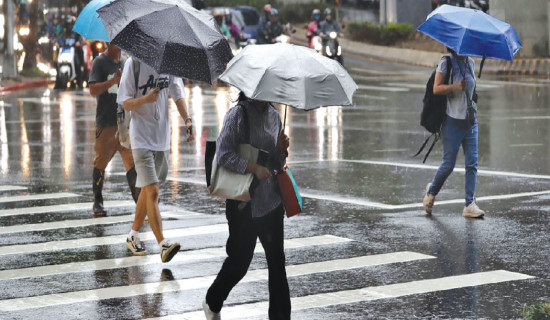- Thursday, 11 December 2025
Winter was too dry, will Spring be wetter?
Kathmandu, Mar. 2: The pre-monsoon season made its foray into Nepal on Wednesday with light rainfall across the country towards the end of winter. According to DHM records, the country received only 19.9 per cent precipitation during the winter. The country remained dry, especially in its central and eastern parts.
This year, in the winter months (1st December 2022 - 28th February 2023), there was less than normal rainfall across the country. Especially in the districts of central and eastern Terai, there was no rain during the period, said Dr. Indira Kandel, senior meteorologist and chief of the Climate Division of the Department of Hydrology and Meteorology.
Weather gauge stations in Bhairahawa, Dang, Simara, Janakpur, Dharan, Dhankuta and Biratnagar have shown that there was no precipitation. Data collected from 20 main stations across the country showed the country received 12.9 mm of precipitation during the period, which is only around 20 per cent. About 60.5 mm is normal precipitation during the winter season, Dr. Kandel informed The Rising Nepal.
If the rainfall is less than 75 per cent of the total volume, it is a condition of drought. “There was some relief of precipitation on February 27 but that was not enough to make the soil moisture,” she added.
Even in the upcoming pre-monsoon period, the Climate Model of some leading organizations including the World Meteorological Organisations, the European Centre, Japan and the UK, have predicted less than average rainfall.
There might be disasters such as wildfires, drying up of water sources, and an increase in air pollution if this drought is prolonged even during the pre-monsoon season, Dr. Kandel added.
Climate change expert and Chairperson at Nepal Water Conservation Foundation for Academic Research Ngamindra Dahal said that the coming spring season will also be drier than average. So, it seems that it would be good for everyone to increase their investment in ponds, wells and other sources of water so that rainwater accumulates in villages and mountains to deal with disasters such as fire.
The negative effects have already been seen in power generation. “If the present drought prolongs even in the pre-monsoon season, rain-fed agriculture will be badly affected,” he added.
According to Dr. Binod Pokharel, Associate Professor at the Central Department of Hydrology and Meteorology, Tribhuvan University, Nepal is always affected by fires. “Below-average rainfall leads to warmer-than-normal temperatures. The effect is seen in devastating wildfires.”
Recently published research by Dr. Pokharel and his team of researchers from Taiwan, Germany and the United States found that a lack of sufficient precipitation and warmer-than-normal temperatures led to huge bushfires across Nepal. Dr. Pokharel’s recently published research paper “Amplified drought trends in Nepal increase the potential for Himalayan wildfires” said that in the forested foothills and hills below the world’s highest mountains, in the spring of 2021, Nepal underwent a wildfire season in which active fires were detected at a rate 10 times greater than the 2002–2020 average.
“The main cause of the fires is drought and rising temperature,” he said. Studies have shown that extreme weather events will increase due to climate change, he added.
An analysis using observational, reanalysis, and climate model ensemble data indicates that both climate variability and climate change-induced severe drought conditions were at play, Dr. Pokharel said.
According to Pokharel, the research was done focusing on the 2021 fires. He said that he made a statistical model to see whether the fire can be predicted or not. They have also studied the issue of whether it is possible to predict the situation of the fire next month by looking at the current situation.
According to him, there is a summary of the study that can predict the future fire situation by looking at the current situation. Based on the current drought, it is estimated at what time and how many fires will occur. “It seems that the fires will increase," Pokharel added. "This year too, the situation of 2021 is expected to repeat. It is expected that fire may break out in certain areas as it is dry and not raining.”
Wildfires in South Asia are mostly human-ignited—sometimes accidentally and sometimes intentionally to prepare land for shifting cultivation, as part of commercial timber harvesting operations, for controlled burning, to encourage grass regrowth, for the collection of minor forest products, and out of firewood burning.
The role of climate drivers in fire regimes is ecosystem-dependent, and a range of regional climate-fire relationships have been well-documented in the USA and Australia. However, similar analyses are less common in South Asia in general and especially in Nepal, he said.
Seasonal fires after the end of summer monsoon are common in Nepal as farmers burn residues of agricultural biomass to manage farmlands and pastures. Most of these fires occur during the hot and dry season, which lasts from March to May. In the winter of 2020 through the spring of 2021, however, Nepal experienced a historic wildfire season.
Multiple lives were claimed in the widespread fires, which also forced school closures due to hazardous air quality. Meanwhile, black and brown carbon deposition was observed across the Himalayas.
This extreme fire season followed anomalously low precipitation between October and March (only 23 per cent of normal, the lowest Nepal-wide precipitation recorded since 1980). Similar cases of drought have been identified as one of the primary drivers for other notable wildfire seasons in Nepal, such as 2008 and 2016.
















